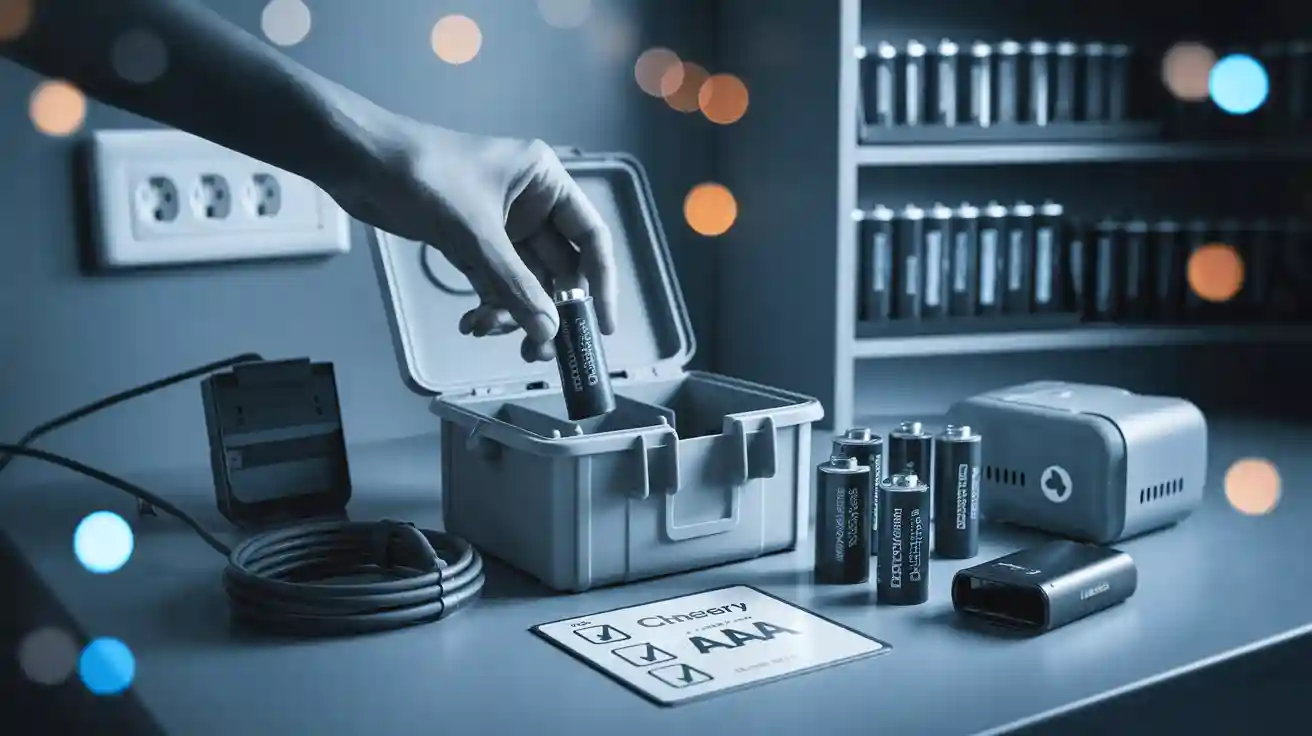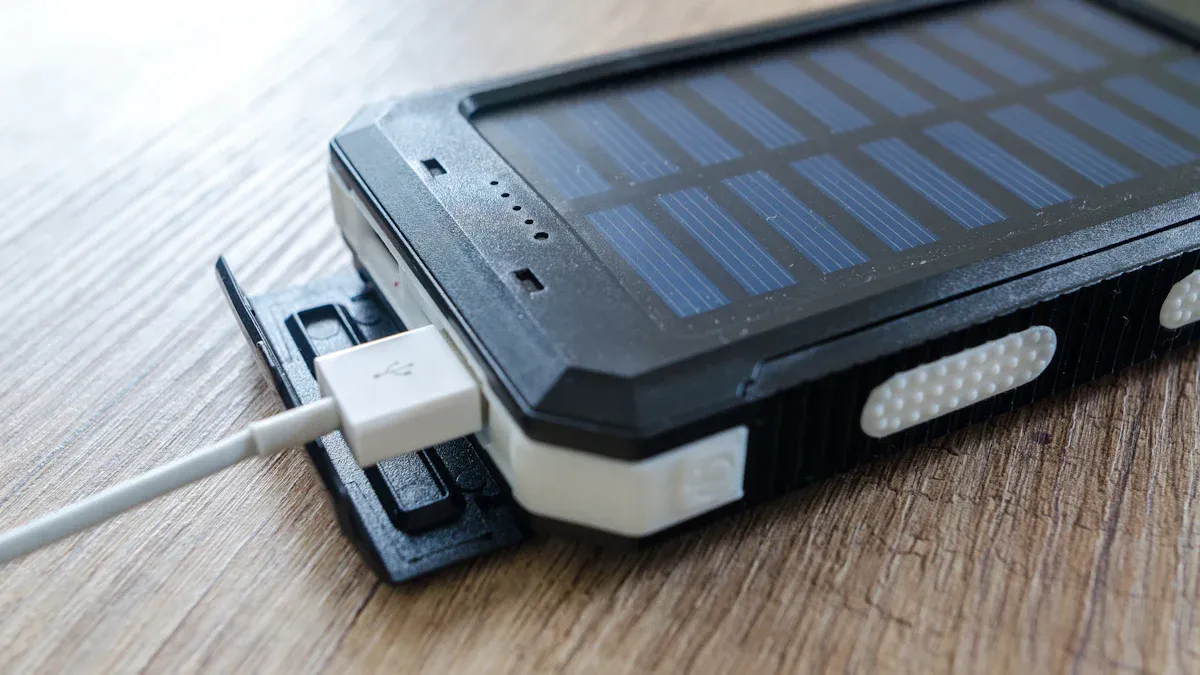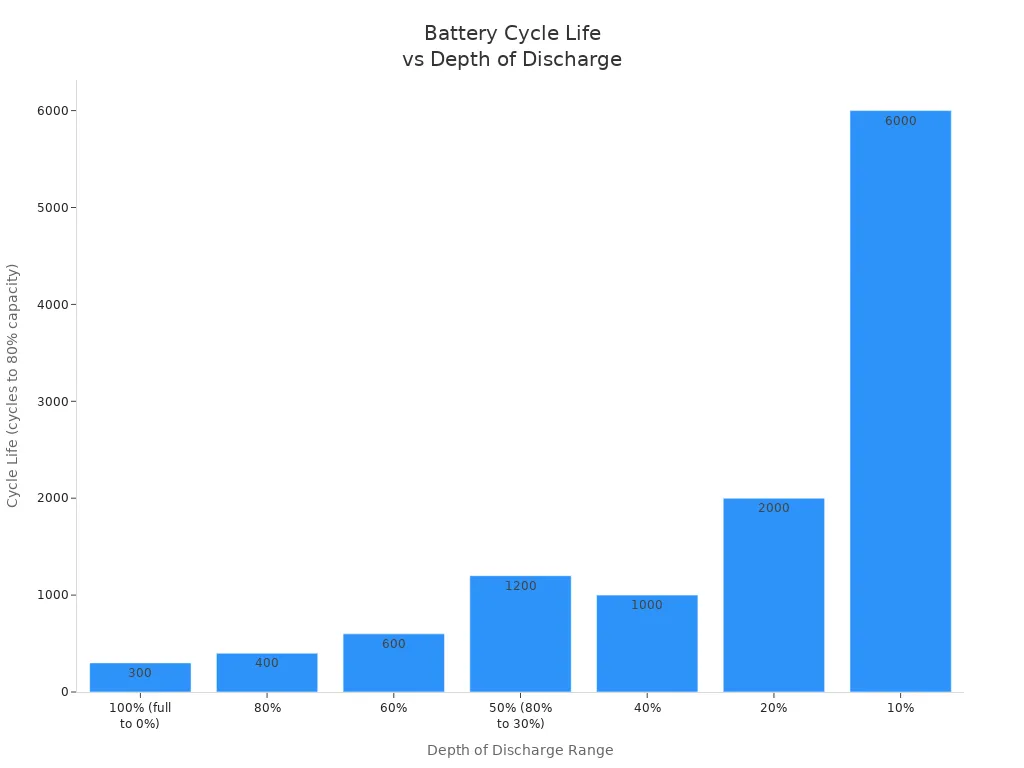
Want your batteries to last longer and keep your devices running safely? Good charging and storage habits make a big difference. When you take care of your batteries, you prevent fires, save money, and keep your gadgets ready when you need them.
- Regular battery maintenance stops failures, cuts down on downtime, and helps you avoid costly repairs.
- Charging with the right charger and keeping batteries at the right temperature can prevent dangerous accidents, like пожары или взрывы.
Most battery problems happen when people use the wrong charger or let batteries overheat. Simple habits keep you safe and help your batteries last.
Battery Maintenance Basics
Battery Types
You probably use different batteries every day, from your TV remote to your phone or laptop. Not all batteries work the same way, and each type needs its own care. Here’s a quick look at the most common batteries you’ll find in your electronics:
| Тип батареи | Usage in Consumer Electronics | Maintenance Needs and Characteristics |
|---|---|---|
| Primary Batteries | Alkaline (AA, AAA, C, N, 9V), Lithium (button cells, AA, AAA) | Single-use, minimal maintenance, require replacement after depletion, long shelf life (5-10 years for alkaline, ~10 years for lithium), low self-discharge, convenient for devices with low power draw or where recharging is inconvenient. |
| Secondary Batteries | Li-ion, Li-Po, Ni-Cd, Ni-Mh (often internal in devices like phones, laptops) | Rechargeable, require proper charging management often via battery management systems to ensure safety and lifespan, avoid memory effect (notably Ni-Cd), and capacity loss. More complex maintenance than primary batteries. |
You’ll see lithium batteries in most modern devices. Lithium-ion battery packs power your phone, laptop, and even electric vehicles. These batteries need more attention than simple alkaline batteries. If you want your lithium batteries to last, you need to follow good battery maintenance habits.
Why Maintenance Matters
Battery maintenance is not just about making your batteries last longer. It also keeps you and your devices safe. When you take care of your lithium-ion battery, you lower the risk of overheating, fire, or even explosions. You should avoid exposing batteries to extreme heat or cold. High temperatures can damage lithium cells and cause safety problems.
Tip: Try not to leave your phone or laptop charging overnight. Unplug it once it’s full to protect the lithium-ion battery.
You can also help your lithium batteries by keeping them between 20% and 80% charged. Avoid letting them drop to zero or stay at 100% for too long. This simple habit reduces stress on the lithium cells and helps them last longer. If you use fast chargers all the time, your lithium-ion battery may get hot and wear out faster. Slow and steady charging is best.
Many electric vehicles use advanced battery management systems. These systems watch the temperature and voltage of each lithium-ion battery cell. They help prevent overheating and keep your vehicle safe. Good battery maintenance, like checking for damage and following the manufacturer’s advice, will keep your lithium batteries healthy and your electronics running smoothly.
Правильные методы зарядки

Keeping your batteries healthy starts with how you charge them. If you want to get the most out of your devices, you need to follow proper charging techniques. These habits help you avoid battery degradation, keep your gadgets safe, and extend the lifespan of your lithium batteries.
Charging Levels
You might think charging your battery to 100% is best, but that’s not true for lithium batteries. Charging all the way up or letting the battery drop to zero can actually shorten its lifespan. Instead, you should aim to keep your battery between 20% and 80% most of the time. This range helps prevent stress on the battery and slows down battery degradation.
- Charge lithium batteries up to about 80% instead of 100% to make them last longer.
- Try not to let your battery drop below 25%. If it does, recharge it as soon as you can.
- Partial charges are better than full cycles. Lithium batteries don’t have a memory effect, so you don’t need to drain them completely.
- For long-term storage, keep your battery at about half charge.
Tip: Charging your battery more often, but only a little at a time, can help you get more cycles out of it.
Here’s a table that shows how different charging habits affect lithium battery lifespan:
| Depth of Discharge (DoD) Range | Approximate Cycle Life (cycles to 80% capacity) | Примечания |
|---|---|---|
| 100% (full charge to 0%) | ~300 | Deep discharge shortens life significantly |
| 80% | ~400 | Reduced DoD improves life |
| 60% | ~600 | Shallower cycling helps |
| 40% | ~1000 | Big boost in cycle life |
| 20% | ~2000 | Very shallow cycling is best |
| 10% | ~6000 | Maximizes longevity |

When you keep your battery in the 20% to 80% range, you can get many more charging cycles. This means your device will last longer before you need a new battery.
Избегайте перезарядки
Leaving your device plugged in after it’s fully charged can cause problems. Overcharging leads to heat, which speeds up battery degradation and can even cause safety risks. When a lithium battery gets too much charge, it can swell, leak, or in rare cases, catch fire. Scientists have found that overcharging causes the battery to expand and break down inside. This process starts even at lower temperatures and can give you an early warning before things get dangerous.
Overcharging also causes chemical reactions inside the battery. These reactions damage the battery’s parts and make it lose capacity faster. You might notice your battery doesn’t last as long or gets hot during the charging process. That’s a sign of battery degradation.
Note: Always unplug your charger once your device reaches 100%. Avoid charging overnight, especially if your device gets warm.
If you use proper charging techniques and avoid overcharging, you protect both your device and yourself.
Выбор зарядного устройства
Choosing the right charger is just as important as how you charge. Not all chargers are created equal. Using the wrong charger can damage your battery, cause overheating, or even start a fire. Manufacturers design chargers to match the voltage and current needs of your device. If you use a charger that doesn’t match, you risk battery degradation and safety hazards.
Here’s what you should look for when picking a charger:
- Match the charger’s voltage exactly to your battery’s needs. For lithium batteries, this is usually 4.2V per cell.
- Pick a charger with the right current. A good rule is to use a charger rated at about 1/4 of your battery’s capacity for slow, safe charging.
- Use a high-quality charger with safety certifications like UL or CE. These marks mean the charger has passed safety tests.
- Avoid cheap or counterfeit chargers. They often skip important safety features and can cause fires or explosions.
- Always follow the manufacturer’s instructions for the charging process.
- Using an incorrect charger can cause overheating, swelling, or even explosions.
- Counterfeit chargers may not have protections against overvoltage or short circuits.
- Buying from certified sources helps you avoid fake products and keeps your battery safe.
Tip: If you’re not sure which charger to use, check your device’s manual or buy directly from the manufacturer.
Proper charging techniques, including the right charging levels, avoiding overcharging, and using a quality charger, will help you get the most out of your lithium batteries. These habits protect your devices, slow down battery degradation, and give you a longer battery lifespan.
Proper Storage

Storing your batteries the right way can make a huge difference in how long they last and how safe they stay. If you want to get the most out of your batteries, you need to pay attention to how you store them. Let’s break down the best battery storage practices so you can keep your batteries healthy and ready to use.
Storage Charge Level
You might think it’s best to store your batteries fully charged or completely empty, but that’s not true. For lithium-ion batteries, the sweet spot is around 40% to 60% charge. This level helps your battery keep its chemical balance and prevents damage. If you store your battery at 100%, it will lose capacity faster. If you let it drop to zero, it could become unusable.
- Store lithium-ion batteries at about 50% charge for the best results.
- Never let the voltage drop below 2 volts per cell. This can cause permanent damage.
- For nickel-based batteries, you can store them charged or discharged, but they lose charge faster if left full. You may need to top them up every few months.
Совет: Check your battery charge every 3 to 6 months. If it drops below 40%, recharge it to 50-60%. This simple habit keeps your battery from deep discharge and helps extend its lifespan.
Keeping your batteries at the right charge level is one of the most important battery storage practices. It protects your battery’s health and gives you more cycles before you need a replacement.
Temperature and Humidity
Temperature and humidity play a big role in battery storage. High temperatures speed up chemical reactions inside your battery, which makes it wear out faster. Humidity can cause corrosion and damage the battery’s parts. If you want your batteries to last, you need to store them in a cool, dry place.
- Сайт best temperature for battery storage is about 59°F (15°C). You can go as low as -40°C or as high as 50°C, but staying close to room temperature is safest.
- Keep humidity between 30% and 50%. Too much moisture can cause rust and leaks.
- Make sure the storage area has good airflow. This helps prevent heat and moisture buildup.
Note: Batteries stored in hot or humid places lose capacity much faster. You might notice swelling, leaks, or even a shorter lifespan if you ignore these conditions.
If you control the temperature and humidity, you slow down battery aging and keep your devices safe. This is a key part of proper storage.
Storage Location
Where you put your batteries matters just as much as how you charge them. The right spot can prevent fires, leaks, and other hazards. Always choose a cool, dry, and well-ventilated area for battery storage.
Here are some tips for safe storage locations:
- Keep batteries away from flammable materials and direct sunlight.
- Use non-conductive, corrosion-resistant cabinets or containers with good ventilation.
- Separate different types of batteries and label them clearly.
- Cover battery terminals with tape or use the original packaging to prevent short circuits.
- Store large numbers of batteries in fireproof containers if possible.
- Inspect batteries for damage before storing. If you see swelling or leaks, dispose of them safely.
Safety Reminder: Never store batteries on combustible surfaces or near chemicals. Always keep your storage area clean and organized to avoid accidents.
By following these battery storage practices, you protect your batteries and everyone around you. Good storage habits help you avoid common problems and make your batteries last longer.
Battery Maintenance Tips
Taking care of your batteries does not have to be hard. You just need a few simple battery maintenance tips to keep your devices safe and running longer. Here are three easy habits you can start today.
Регулярный осмотр
You should make regular inspection part of your battery maintenance routine. This helps you spot problems before they get worse and prevent battery failure. Try these steps every month:
- Look at the battery and its compartment. Check for corrosion, crusty spots, bulges, or any strange colors.
- Use a flashlight or magnifying glass if you need to see small details.
- Gently touch the battery case. Feel for swelling or soft spots.
- Smell the battery. If you notice a sharp or sour odor, it could mean a leak.
- Always wear gloves and safety goggles when you check batteries.
- Handle batteries with care. Do not squeeze or drop them.
- Replace any battery that looks swollen or leaks right away.
Совет: Never mix old and new batteries or store loose batteries with metal objects. This can cause short circuits.
By following these battery maintenance tips, you can catch early signs of trouble and keep your devices safe.
Clean Terminals
Dirty or corroded terminals can stop your battery from working well. You should clean terminals and cables at least once a year. If you live in a hot or humid place, check them every month. This simple step keeps your battery connections strong and helps your devices run better.
- Use a dry cloth or a small brush to wipe away dirt.
- If you see white or green buildup, mix a little baking soda with water and gently scrub the terminals.
- Dry everything before putting the battery back.
Note: Clean terminals help prevent battery failure and keep your devices working their best.
Monitor Charge
If you want to monitor battery life and avoid problems, keep an eye on your battery’s charge level. Try to keep the заряд между 20% и 80%. Charging too much or letting the battery get too low can shorten its life.
- Charge your battery before it drops below 20%.
- Unplug your device once it reaches 80% or 100%.
- Avoid fast charging unless you really need it.
- Park your electric devices in cool, shaded spots to avoid heat.
- Trust your device’s battery management system to help you monitor charge.
Following these battery maintenance tips will help you get more life from your batteries and prevent battery failure.
Extending Lithium Battery Lifespan
Partial Charging
If you want your lithium batteries to last, you should try partial charging. This means you keep your battery between 20% и 80% most of the time. Charging all the way to 100% or letting it drop to zero puts stress on the battery. When you follow the “80% Rule,” you help your battery avoid high voltage stress. This simple habit can double your battery’s lifespan.
Many electric cars and smartphones use this method to extend battery life. Research shows that when you keep your lithium battery in the 20% to 80% range, you get thousands of charge cycles. Charging to 100% speeds up chemical changes inside the battery, which leads to battery degradation and a shorter lifespan. Even small, shallow charges—called micro-cycles—can boost lithium battery lifespan by up to 50%. These micro-cycles mean you use only a little bit of the battery before charging again. If you do this, your battery could last for years.
Tip: Try to charge your device when it drops to about 30% and unplug it when it reaches 80%. This habit helps you extend battery life and keeps your devices running longer.
Avoid Deep Discharge
Deep discharges happen when you let your lithium battery drop below 20% or even close to zero. This can cause a lot of damage inside the battery. When you use most of the battery’s power before recharging, you speed up degradation. The battery’s parts break down, and the battery gets hot. Over time, this makes the battery lose its ability to hold a charge.
- Deep discharges cause the battery’s electrodes to wear out faster.
- The battery’s protective layer gets thicker, which makes it harder for energy to flow.
- The battery can swell or even leak if you keep draining it too much.
- Heat from deep discharges makes the battery age quickly.
If you avoid deep discharges and recharge your battery before it gets too low, you help preserve its health. Shallow discharges—using only 10% to 30% of the battery before charging—are much better for battery lifetime extension. Many battery warranties do not cover damage from deep discharges, so it is smart to avoid them. By following these tips, you can extend battery life, reduce battery degradation, and get the most out of your lithium battery lifespan.
Распространенные ошибки
Everyone makes mistakes with batteries sometimes. If you know what to avoid, you can keep your devices safe and prevent battery failure. Let’s look at the most common battery mistakes and how they can hurt your battery’s health.
Перезарядка
Overcharging happens when you leave your device plugged in after it’s already full. This mistake can cause big problems. When you overcharge, the battery gets hot. The heat can make the battery swell, leak, or even catch fire. You might see your battery bulge or notice a strange smell. These are warning signs that you should never ignore.
Overcharging stresses the battery’s parts and raises the risk of fire. If you use a non-certified charger or charge for too long, the danger goes up.
Here’s what can happen if you keep overcharging:
- The battery shell swells up.
- Liquid leaks out.
- The battery can burst and release gas.
- In some cases, the gas can catch fire.
Always unplug your device when it’s charged. This simple habit helps prevent battery failure and keeps you safe.
Wrong Charger
Using the wrong charger is another common mistake. Not all chargers are the same. If you use a charger with the wrong voltage or current, you can damage your battery. The battery might get too hot, swell, or even stop working. Sometimes, a low-quality charger can cause short circuits or sparks.
- Always check that your charger matches your device’s needs.
- Use chargers made for your battery type, especially for electric vehicles and other high-power devices.
- If you notice smoke, sparks, or a burning smell, unplug everything right away.
A quality charger protects your battery and helps it last longer. Cheap or fake chargers can ruin your battery and put you in danger.
Extreme Conditions
Batteries do not like extreme heat or cold. If you leave your battery in a hot car or under direct sunlight, it can get damaged fast. High temperatures speed up chemical reactions inside the battery. This makes the battery age faster and can even cause it to leak or catch fire. Cold weather is also bad. It can cause parts inside the battery to break down, which means your battery won’t hold a charge as well.
- Keep batteries at room temperature when you can.
- Never leave batteries in vehicles during hot or freezing weather.
- Store batteries away from sunlight and heat sources.
Batteries in electric vehicles need special care. Extreme temperatures can shorten their life and lower their performance.
If you avoid these common mistakes, you will help your batteries last longer and work better. Good habits and quality products make a big difference.
You can make your batteries last longer and keep your devices safe with a few simple habits:
- Заряд между 20% и 80% to slow down aging and avoid deep discharges.
- Store batteries in cool, dry places away from sunlight and heat.
- Clean terminals and check for damage often.
- Use the right charger and follow manufacturer instructions.
Good battery care means fewer failures, safer devices, and less electronic waste. Start these habits today and help protect both your gadgets and the planet! 🌱
ЧАСТО ЗАДАВАЕМЫЕ ВОПРОСЫ
How often should you check your batteries for damage?
You should check your batteries once a month. Look for swelling, leaks, or strange smells. If you see any of these signs, replace the battery right away. Regular checks help you catch problems early and keep your devices safe.
Can you leave your device plugged in overnight?
It’s best not to leave your device plugged in overnight. Overcharging can heat up the battery and shorten its life. Unplug your device when it’s fully charged. This simple habit helps your battery last longer.
What should you do if a battery gets hot while charging?
Stop charging right away if your battery feels hot!
Let it cool down before using it again. If it keeps getting hot, replace the battery or charger. Hot batteries can be dangerous.
Is it safe to store batteries in the refrigerator?
No, you should not store batteries in the refrigerator. Cold and moisture can damage them. Store your batteries in a cool, dry place at room temperature for the best results.
How can you make your battery last longer?
- Заряд между 20% и 80%
- Avoid deep discharges
- Store in a cool, dry place
- Use the right charger
😊 These habits help you get more life from every battery!

